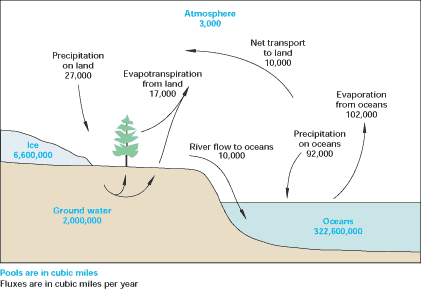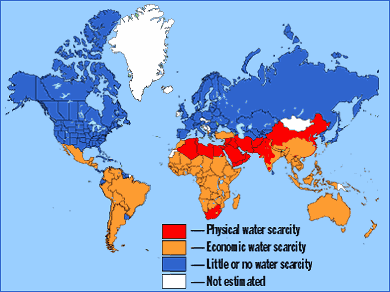Is water the Key Limiting Factor?
Water is one resource that has no substitute. Although water covers three quarters of the planet, 97% of the Earth's water is salt water, and thus useless for drinking (and many other purposes). While some desalination is currently used, this is limited by factors from the costs of desalination plants, to their limited capacity, to concerns over disposal of brines/wastes from the desalination process.
Less than 3% of water is freshwater (much of it groundwater that has accumulated over time and is virtually nonrenewable. Rainwater is thus critical; the "global water cycle accounts for the only naturally renewable source of fresh water, that is, precipitation that occurs over land." Aquifer pumping is reducing our water resources. People living in arid regions, and even some not so arid regions, have been relying heavily on groundwater resources that accumulated over thousands of years. Removing this water at such rapid rates spends this resource many times faster than it can be replaced, leads to the deterioration of what water is left, and also can cause collapse of aquifers.
Groundwater and the hydrological cycle
Source: http://water.usgs.gov/pubs/circ/circ1139/htdocs/natural_processes_of_ground.htm
Pollution of freshwater is a constant concern, making prevention measures and sewage treatment crucial. Despite all of this, there might be enough freshwater available for earth's growing population, but unfortunately not in the places where population chooses to settle. In the Southwestern United States, for instance, industrial and agricultural water use have lowered aquifers and are not sustainable, while consumers bring habits from areas with radically different conditions, such as lush lawns requiring frequent watering.
Water resources increasingly drive economic and political decision-making. Anticipating an accelerating water shortage, corporations are buying and selling water rights; the ubiquity of brand-name bottled water is one indication that a resource once considered free and public is changing in status. Water is a source of conflict that is likely to accelerate in the future. In the Middle East, for instance, access to Jordan River water is contested between Israel and the Palestinians to the extent that the issue has been delayed until final status negotiations (placing it on a par with the holy city of Jerusalem). Barring a miracle breakthrough in desalination technology, water disputes are likely to become more common in the near future. Still, according to Lester Brown, with conservation and productive use, water resources can be stretched much further than is currently happening.
Global water scarcity Source: http://whyfiles.org/131fresh_water/2.html
Water resources are threatened in numerous other ways, often linked to other forms of ecosystem health. Coastal waters suffer eutrophication, while damming of rivers causes a number of problems, including changing habitat both above and below the dam, and decreasing sediment flow to the coastline leading to increasing rates of coastal erosion. Draining of wetlands destroys habitat and causes loss of such ecosystem functions as filtering water and recycling carbon. A macro look at the state of our water reveals the numerous, complex linkages between environmental categories.

